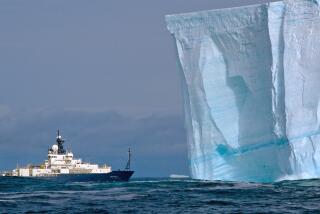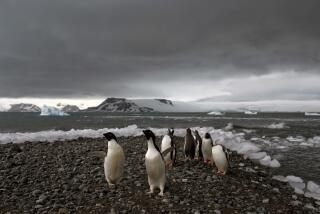Antarctic Trek With Skis, Dogs Breaks Record : Adventure: The crossing by an international team is meant to build support for protecting the continent from development.
- Share via
PARIS — Six weary but jubilant adventurers from six nations completed a seven-month, 3,800-mile trek across Antarctica on skis and dog sleds Saturday, in the longest unmechanized crossing of the continent.
“It’s a dangerous land, without mercy,” co-leader Jean-Louis Etienne of France said moments after the team arrived at a Soviet base on the Indian Ocean coast.
The men were given a huge loaf of fresh bread and chugged champagne as the flags of their homelands flapped above them in a strong wind.
Besides Etienne, the team included American co-leader Will Steger of Ely, Minn.; Victor Boyarsky of the Soviet Union; Geoff Somers of Britain; Quin Dahe of China, and Keizo Funatsu of Japan.
Interviewed on ABC-TV’s “Wide World of Sports,” Steger was asked what he intends to do now that the journey has ended. He laughed and said: “Take a sauna.”
“We can relax and join the human race again,” he said.
The Minnesota-based expedition almost ended in tragedy in its final hours. As the team struggled through a storm toward the Soviet research base of Mirnyy, Funatsu disappeared in a blizzard for 11 hours before he was found Friday.
Steger said it was “very close. We were lucky we found him.”
The crossing was by far the longest of its type across Antarctica, but apparently not the first without motor power.
On Feb. 12, Italian mountaineer Reinhold Messner and West German adventurer Arved Fuchs completed what they said was a 1,700-mile crossing on foot, without the use of sled dogs. They are expected to arrive in Frankfurt later this month to provide details of their journey.
Etienne’s team is scheduled to return to France for welcoming celebrations March 21. They then head to the United States for ceremonies in Minneapolis--which along with Paris served as expedition headquarters--and in Washington, where President Bush is expected to meet them at the White House.
Bush, in a congratulatory message, said: “Your spirit of international friendship and cooperation not only helped make this fantastic journey possible but also set a wonderful example for the world community of nations.”
The expedition, undertaken at a cost of about $11 million after three years of planning, was intended to build support for Antarctica’s preservation and demonstrate the power of international cooperation. The members had their expenses paid, but they received no salaries.
“Antarctica isn’t threatened by pollution, it’s still virgin and white,” Etienne said in a hookup with reporters in Paris. “All countries should forget their partisan interests and offer it to the world. . . . This continent belongs to everyone.”
He described Antarctica as “huge and sometimes monstrous.” In seven months, he said, the only other living things seen by the team were their sled dogs and three birds.
Experts at expedition headquarters in Paris praised the performance of the sled dogs, which were trained by Steger. All but one of the 36 dogs used on the expedition survived, and a special high-nutrition diet appeared to have kept them in excellent health.
The journey began July 28 near the tip of the Antarctic Peninsula, which reaches out toward South America. On Dec. 11, the team reached its halfway point, becoming the first to reach the South Pole by dog sled since Roald Amundsen in 1911.
“The first two months were very, very hard,” Etienne said. “We started to doubt after a month whether we would make it.”
It had been feared bad weather might strand the adventurers on the continent for as long as a month and jeopardize an elaborate international tour to tout the expedition.
But high winds pushed apart ice that had blocked the Mirnyy harbor, leaving a path for a ship that will take them to New Zealand. Soviet Antarctic officials in Leningrad told Cathy DeMoll, the expedition’s manager in Paris, that unless conditions change, loading of the ship will begin Monday.
The wind was howling at 70 m.p.h. and the temperature was 20 degrees below zero when Funatsu went outside his tent, a spokeswoman in Minnesota said.
When Funatsu did not arrive back in his tent for dinner, team members tied themselves together and searched the area for several hours before giving up because of darkness. The search resumed early Friday, and Funatsu was found about two hours later, expedition staff reported.
Etienne said that when expedition members passed Funatsu calling “Keizo! Keizo! Keizo!” he “jumped out like a mushroom from the snow. He was in very good shape.”
“He had survived by digging a hole in the snow and crawling inside, just as the dogs do each night to stay warm,” the spokeswoman said.
Trans-Antarctica Expedition Route A seven-month 3,800-mile dogsled trek by explorers from six countries. 1: From China’s Great Wall Station on King George Island on July 28, 1989 2: Team reaches halfway point on Dec. 11, the first time by dogsled since Roald Amundsen discovered the pole in 1911. 3: At the Soviet base, Mimyy, on March 3, 1990.
More to Read
Sign up for Essential California
The most important California stories and recommendations in your inbox every morning.
You may occasionally receive promotional content from the Los Angeles Times.













